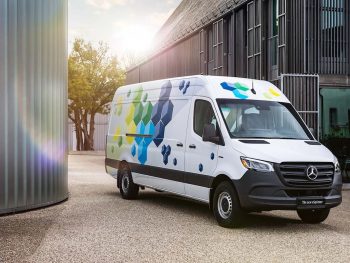Can the upgraded battery-powered Transit-rival compete with Ford’s finest? George Barrow finds out.
 Launched with a 113kWh battery, the new eSprinter has a claimed range of 271 miles, dwarfing the E-Transit’s 68kWh battery and 196-mile range. There’ll also be an 81kWh battery option and, unofficially for the UK, a 56kWh version.
Launched with a 113kWh battery, the new eSprinter has a claimed range of 271 miles, dwarfing the E-Transit’s 68kWh battery and 196-mile range. There’ll also be an 81kWh battery option and, unofficially for the UK, a 56kWh version.
Previously there was just one body size for the eSprinter, a run-of-the-mill long wheelbase and standard height panel van. However, the new model gets panel van or chassis cabs, in two body lengths and two trim options. Later, there will also be off-the-line conversions for dropside and refrigerated vans.
It’s a belt-and-braces approach to cover off the segment in much the same way that the ICE model has become known for. Load volumes are up to 14m3 and payload in the panel vans will be as much as 1,575kg, thanks in part to a 4.25-tonne GVW for the largest battery models. O-licensing and drivers’ licence issues aside, the top-spec Select trim with 113kWh battery and 204hp/150kW motor – there’s also a 136hp/100kW option – is capable of some impressive numbers. Delivering a payload of 995kg and 263-mile claimed range, it can also charge at up to speeds of 115kW, allowing the battery to go from 10% to 80% in just 42 minutes. Although charging on a single-phase supply at 7kW will apparently take up to 17 hours, fleet buyers – which the eSprinter is unashamedly aimed at – will likely have the infrastructure for rapid recharging.
On the inside, the eSprinter has undergone a large upgrade with the latest MBUX system. A 10.25-inch central screen is standard on all models and includes wireless smartphone connectivity. It’s just part of the generous standard equipment on the entry-level Pro trim, which also includes heated electric mirrors, multifunction steering wheel, heated front driver seat, cruise control, air conditioning and a reversing camera.
There’s also a huge number of safety systems fitted as standard, with particular highlights being blindspot assist, active lane keeping assist and intelligent speed assist. Upgrading to the Select trim adds just a handful of items, the most important of which is LED headlights with automatic high beam assistance. With a much more powerful motor and a new larger battery, the eSprinter is radically different to its predecessor.
The most powerful 204hp/150kW motor is equivalent to 204hp and drives 400Nm of torque to the rear wheels. Consequently, it feels like a proper Sprinter van and behaves like one too. In fact, it handles better than the ICE equivalent thanks to its low-slung batteries and fast and responsive electrically assisted steering. Ride comfort is typically Mercedes and it is also deadly quiet in the cabin, thanks to excellent sound deadening. It’s an accomplished overhaul that even lives up to the manufacturer’s range claims when using the most frugal Maximum Range setting of the three driving modes. It reduces power by 20% to ensure a light foot and less battery drain from ancillaries such as air conditioning. Further gains can be made from the regenerative braking system, which now includes a new D Auto mode, giving five levels of regen from the steering wheel-mounted paddle selectors. D Auto uses the radar-sensor to select the optimum amount of regen based on traffic or topography. It’s not perfect but it takes the decision-making out of selecting regenerative levels and also smooths out the transition between power to the wheels and braking.
VERDICT
A credible electric Sprinter has been a long time coming but with this new version Mercedes-Benz has addressed its shortcomings.
Key fleet model: Mercedes-Benz eSprinter 100kWh L2 350 Pro (On sale Q3 2024)
Pros: Convincing new upgrade for in-demand big Merc van
Cons: 4.25-tonne GVW for largest battery vans
Seven-word summary: Fleet favourite electric Sprinter gets massive battery
IN BRIEF
WHAT IS IT? The second generation of Mercedes-Benz eSprinter
MODEL TESTED? Mercedes-Benz eSprinter 113kWh L3 420 Select
HOW MUCH? £76,920 (ex VAT)
RANGE? Up to 271 miles (WLTP combined)
LOAD VOLUME? 14m3 (L2H1)
GROSS PAYLOAD? 995kg
DRIVE? 204hp/400Nm rear-mounted motor, rear-wheel drive with 113kWh under-floor battery packs
CHARGING? 115kW on-board DC rapid charger

